DeepSeek-V2 到底有多强?写一个 AI 编码 Agent 测测看(附详细代码)
深度求索昨晚宣布开源他们第二代 MoE 模型 DeepSeek-V2,支持 128K 上下文窗口,在主流的大模型能力测试集上都有不俗的表现,特别是知识、数学、推理、编程方面能力处于前列,而且成本直接低出一个数量级,到底表现怎么样,本着务实的态度,这篇文章结合 LangChain 的 LangGraph 组件库,编写一个编码类 AI Agent,来对其能力做下简单验证。
在这篇文章中,我会先解释下 DeepSeek-V2 如何做到模型性能强的同时推理成本还低的,然后对 LangGraph 组件进行介绍,最后设计一个能够自动编写生产可用的单元测试代码的编码类 Agent 来验证下 DeepSeek-V2 的实际能力。
我的新书《LangChain 编程从入门到实践》已经开售,推荐准备和正在学习 AI 应用开发的朋友购买阅读!
DeepSeek-V2 介绍
1. 背景了解
DeepSeek 背后的公司深度求索是幻方旗下的大模型初创公司(2023 年 7 月成立),幻方是一家很早就开始使用 AI 进行投资的量化基金(做到过千亿规模),2019 年,幻方就成立 AI 公司,其自研的深度学习训练平台「萤火一号」搭载了 1100 块 GPU,2021 年,「萤火二号」搭载了约 1 万张英伟达 A100 显卡,在技术积累和算力储备方面都实力不俗,所以在看到技术报告后,应该可以排除炒作的嫌疑。详细可以看看这篇 👉 疯狂的幻方:一家隐形 AI 巨头的大模型之路[1]
2. DeepSeek-V2 有多强
在目前大模型主流测试集上,DeepSeek-V2 均表现出色:
- 开源模型中中文综合能力(AlignBench)最强,与 GPT-4-Turbo、GLM-4 等闭源模型处于同一梯队
- 英文综合能力(MT-Bench)与最强的开源模型 LLaMA3-70B 同处第一梯队,超过最强 MoE 开源模型 Mixtral 8x22B
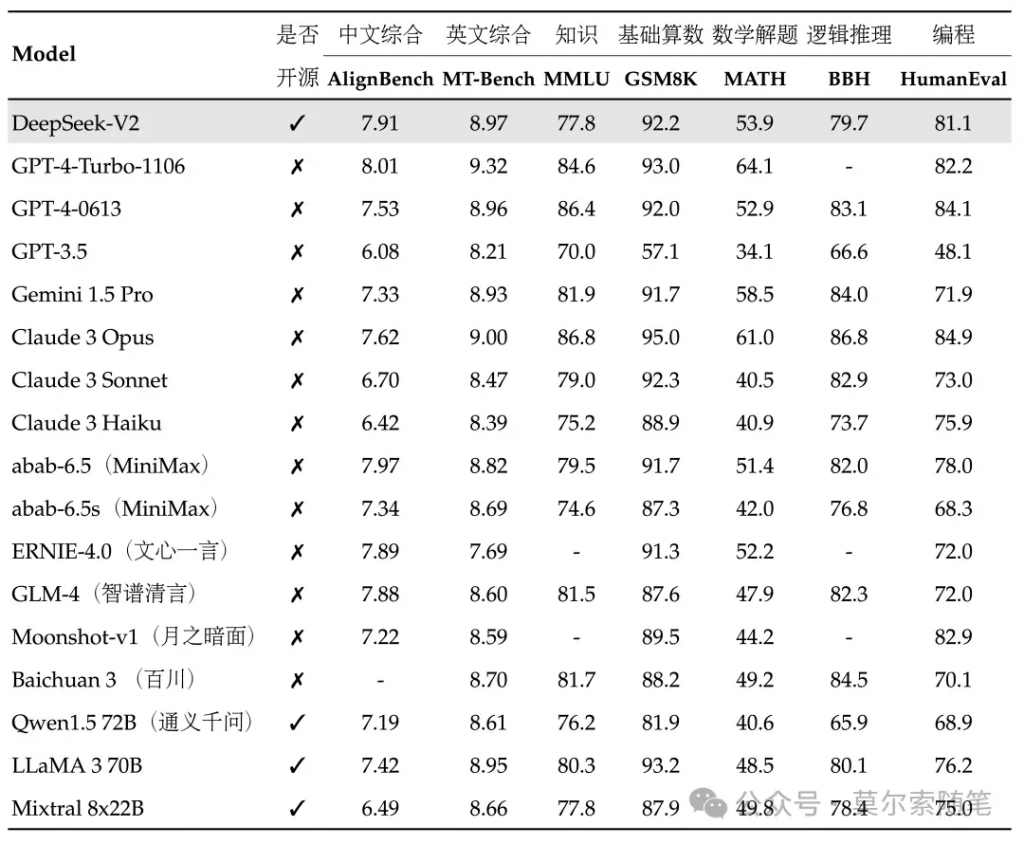 价格方面,DeepSeek-V2 API 的价格为 每百万 tokens 输入 1 元、输出 2 元(32K 上下文),价格仅为 GPT-4-Turbo 的近百分之一,LLaMA3-70B 出来时的成本已经震惊我了,DeepSeek-V2 这波属于是杀红眼了 🫠,对应用层是极大的利好。
价格方面,DeepSeek-V2 API 的价格为 每百万 tokens 输入 1 元、输出 2 元(32K 上下文),价格仅为 GPT-4-Turbo 的近百分之一,LLaMA3-70B 出来时的成本已经震惊我了,DeepSeek-V2 这波属于是杀红眼了 🫠,对应用层是极大的利好。
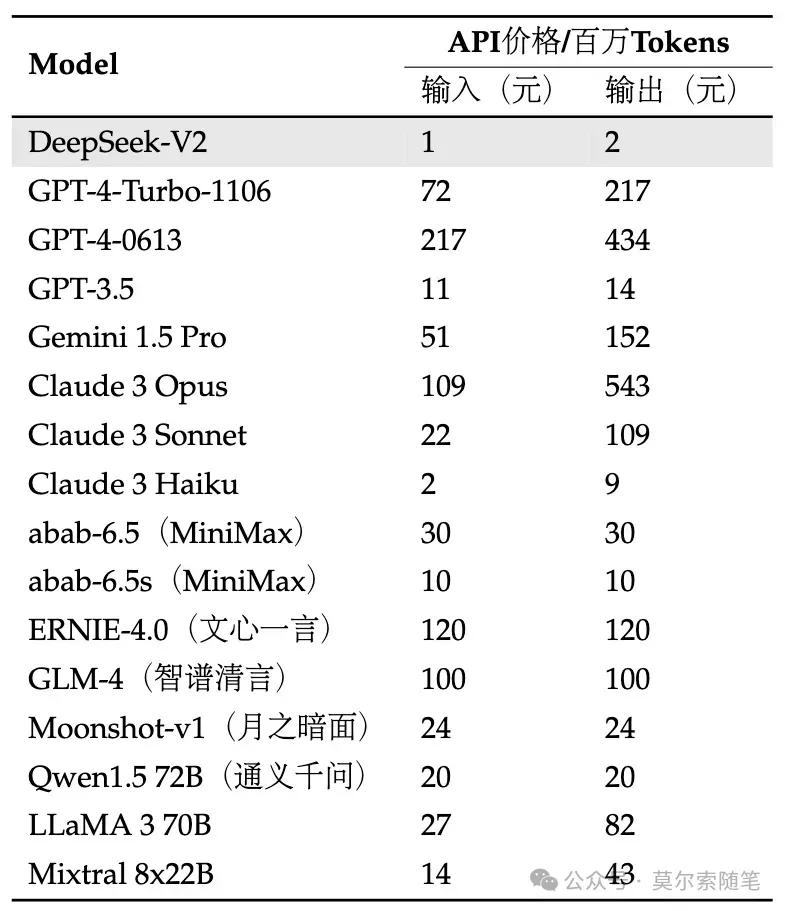 DeepSeek-V2 在中文方面是最好用的,价格也是最便宜的(社区里微调 LLaMA3-70B 中文版的朋友估计哭晕在厕所了 😂)
DeepSeek-V2 在中文方面是最好用的,价格也是最便宜的(社区里微调 LLaMA3-70B 中文版的朋友估计哭晕在厕所了 😂)
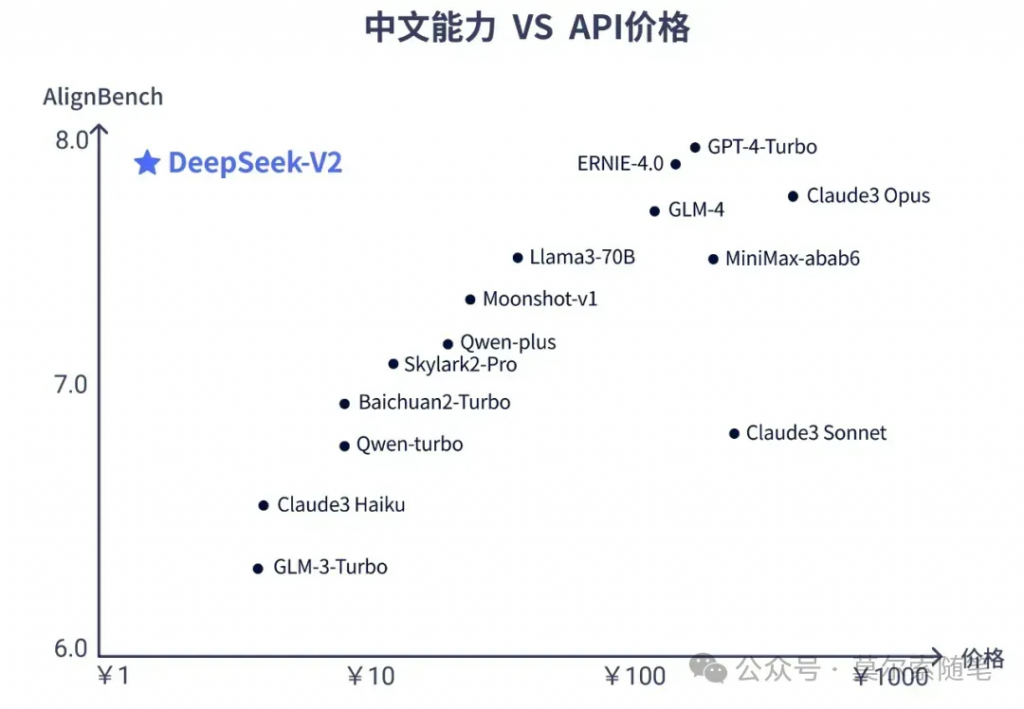
3. DeepSeek-V2 为什么这么强
对 Transformer 架构中的自注意力机制进行了全方位的创新
- DeepSeek-V2 没有沿用类 LLaMA 的 Dense 结构和类 Mistral 的 Sparse 结构,而是对模型框架进行了全方位的创新,提出了媲美 MHA(Multi-Head Attention )的 MLA(Multi-head Latent Attention)架构,大幅减少计算量和推理显存
- 自研 DeepSeekMoE(DeepSeekMoE 主要包括细粒度专家和共享专家这两个特点,在激活和总专家参数数量相同的情况下,DeepSeekMoE 可以大幅超越传统的 MoE 架构[2](Mixture-of-Experts,专家混合) )进一步将计算量降低到极致,两者结合最终实现模型性能跨级别的提升
- DeepSeek-V2 包含 236B 参数,每个 Token 激活 2.1B 参数,支持长达 128K 的上下文,大致达到 70B~110B Dense 的模型能力,同时消耗的显存只有同级别 Dense 模型的 1/5~1/100,每 token 成本大幅降低。实际部署在 8 卡 H800 机器上,输入吞吐量超过每秒 10 万 tokens,输出超过每秒 5 万 tokens。
更详细的技术解读请看这篇 👉 幻方发布全球最强 MOE 大模型!DeepSeek-V2
4. 更多内容
- 技术报告:https://github.com/deepseek-ai/DeepSeek-V2/blob/main/deepseek-v2-tech-report.pdf
- 代码仓库:https://github.com/deepseek-ai/DeepSeek-V2
- 模型权重:https://huggingface.co/deepseek-ai
- API Key 申请:https://platform.deepseek.com
总结
一句话总结:参数更多、能力更强、成本更低!当然能不能干活,我得试了才知道,所以我决定使用 LangChain 的 LangGraph 组件构建一个编码类 Agent 测试下(编码能力、工具调用能力、推理能力),顺便提下,自从上次 LLaMA3-70B 发布,我还在测试其在各类开源 Agent 项目中的实际效果,接下来要替换为 DeepSeek-V2 了。
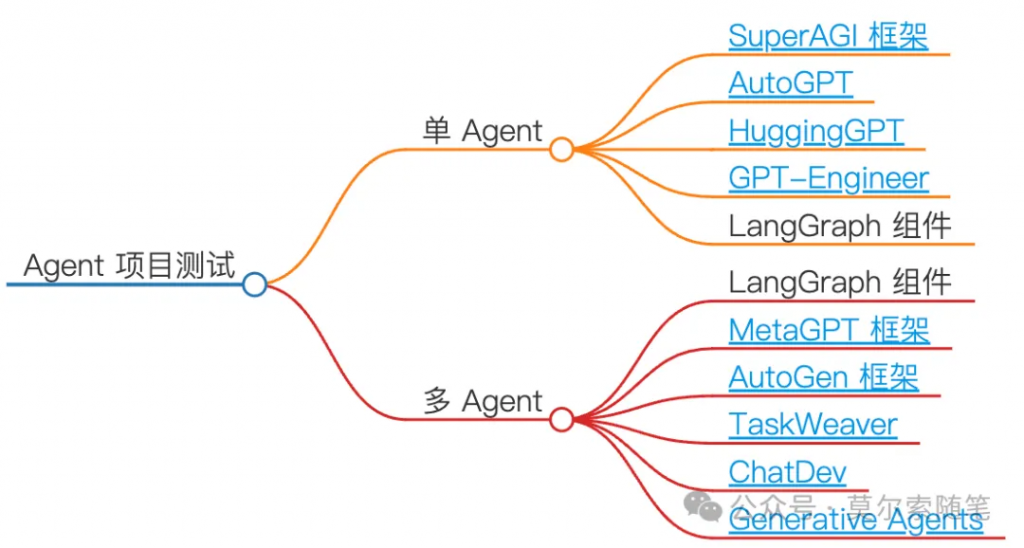
LangGraph 介绍
LangGraph 是一套构建于 LangChain 框架之上的开发组件,可以与 LangChain 现有的链(Chain)、LCEL(LangChain Express Language)等无缝协作,与其生态系统完全兼容。
LangGraph 受到 NetworkX 框架的启发,将应用流程抽象为一个图,其中节点表示一个函数调用或一次大模型调用,而边(则代表了节点的执行顺序(即数据流),并且可以通过设置条件边(conditional edge)来实现流程的分支控制,进而基于此图编译生成相应的应用。在任务执行期间,系统维护一个中央状态对象(state),该对象会随着节点跳转而持续更新,其包含的属性可根据需求自由定义,这种方式使得创建具有状态管理和可控循环的 LLM 应用变得容易,比如多 Agent 应用。LangGraph 的作用包括:
- 分解问题:将复杂问题分解成更小的部分,便于管理和解决。
- 分配任务:将分解后的问题分配给专门的 Agent,每个代理可以专注于解决特定的子问题。
- 协作:允许不同代理之间进行信息交流和协作,以达成共同的目标。
- 状态化:保持对代理间交互和问题解决过程的跟踪,确保协作的连贯性和效率。
下面是官方通过使用 LangGraph 构建 RAG 应用的示意图,晰地阐释了 LangGraph 中的 3 个核心概念:
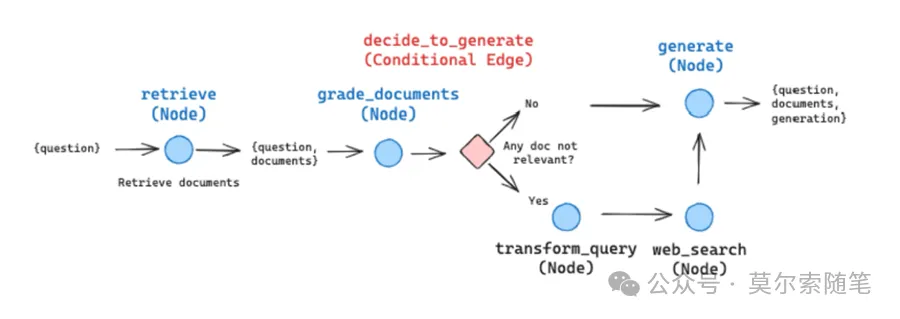 – StateGraph:状态图。通过提供状态定义来初始化此类,该状态定义代表了一个随时间推移而更新的核心状态对象。
– StateGraph:状态图。通过提供状态定义来初始化此类,该状态定义代表了一个随时间推移而更新的核心状态对象。
- Nodes:节点。在创建 StateGraph 后,可通过 graph.add_node(name, value)方法添加节点。
- Edges:边。添加节点后,需向图中引入边,这些边象征着从一个节点到另一个节点的转移关系。当前支持三种边类型:起始边(Starting Edge)、条件边(Conditional Edge)和普通边(Normal Edge)。
代码示例
下面的代码展示了如何基于 DeepSeek-V2 和 LangGraph 实现一个 AI 编码代理,为 Python 代码自动编写单元测试。部分代码参考自 Build an AI Coding Agent with LangGraph by LangChain[3]
配置环境
首先配置环境,并安装基础依赖。
mkdir langgraph_test && cd langgraph_test
python3 -m venv env
source env/bin/activate
pip install langgraph langchain langchain_openai colorama创建示例文件
将code字符串写入到文件中
# 定义搜索路径,即app目录的绝对路径
search_path = os.path.join(os.getcwd(), "app")
# 定义crud.py文件的路径,该文件位于search_path/src目录下
code_file = os.path.join(search_path, "src/crud.py")
# 定义测试文件test_crud.py的路径,该文件位于search_path/test目录下
test_file = os.path.join(search_path, "test/test_crud.py")
# 检查search_path路径是否存在,如果不存在则创建
if not os.path.exists(search_path):
os.mkdir(search_path)
# 创建search_path目录
os.mkdir(os.path.join(search_path, "src"))
# 在search_path下创建src目录
os.mkdir(os.path.join(search_path, "test"))
# 在search_path下创建test目录
# 定义一个包含Item类和CRUDApp类的字符串,这些类将被写入到code_file文件中
code = """
class Item:
def __init__(self, id, name, description=None):
self.id = id
# 初始化Item对象的id属性
self.name = name
# 初始化Item对象的name属性
self.description = description
# 初始化Item对象的description属性,可省略
def __repr__(self):
# 定义对象的字符串表示方法,便于打印和调试
return f"Item(id={self.id}, name={self.name}, description={self.description})"
class CRUDApp:
def __init__(self):
self.items = []
# 初始化一个空列表,用于存储Item对象
def create_item(self, id, name, description=None):
# 创建一个Item对象,并将其添加到items列表中
item = Item(id, name, description)
self.items.append(item)
return item
# 返回创建的Item对象
def read_item(self, id):
# 根据id读取Item对象
for item in self.items:
if item.id == id:
return item
# 如果找到匹配的id,返回Item对象
return None
# 如果没有找到匹配的id,返回None
def update_item(self, id, name=None, description=None):
# 根据id更新Item对象的name和/或description属性
for item in self.items:
if item.id == id:
if name:
item.name = name
# 如果提供了name,更新Item对象的name属性
if description:
item.description = description
# 如果提供了description,更新Item对象的description属性
return item
# 更新完成后返回Item对象
return None
# 如果没有找到匹配的id,返回None
def delete_item(self, id):
# 根据id删除Item对象
for index, item in enumerate(self.items):
if item.id == id:
return self.items.pop(index)
# 如果找到匹配的id,从列表中移除Item对象并返回
return None
# 如果没有找到匹配的id,返回None
def list_items(self):
# 返回所有存储的Item对象的列表
return self.items
"""
# 使用with语句打开code_file文件进行写入
with open(code_file, 'w') as f:
f.write(code)
# 将code字符串写入到文件中示例文件创建好后,接下来编写 Agent 处理逻辑,即为这段代码(code 字符串内容)自动生成单元测试。
编写 Agent 应用
大模型 API
开始之前先设置好 DeepSeek-V2 大模型,由于 API 格式与 OpenAI 兼容 ,所以可以直接使用 OpenAI SDK (langchain_openai)来访问 DeepSeek API。
llm = ChatOpenAI(base_url="https://api.deepseek.com/v1",
api_key=os.getenv("DEEPSEEK_KEY"),
model="deepseek-chat")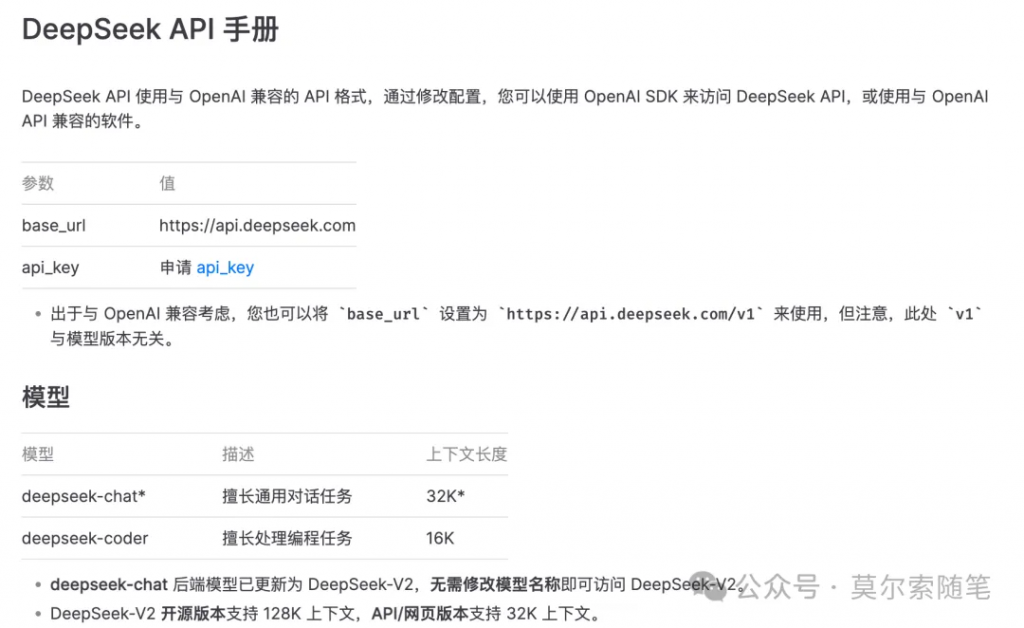
1. 定义 StateGraph
首先定义一个 AgentState,负责在执行过程中跟踪代理的状态。这主要是一个 TypedDict 类,其中包含 Agent 状态相关属性。
class AgentState(TypedDict):
# 定义AgentState类型,用于存储代理的状态
class_source: str
class_methods: List[str]
tests_source: str# 创建StateGraph
workflow = StateGraph(AgentState)class_source 存储代码中的 Python 类名称,class_methods 用于存储 Python 类类的方法,tests_source 用于存储生成的单元测试代码。
2. 定义节点
现在为 AgentState 添加节点,这里需要定义 3 个节点,一个用于查找类方法的节点,一个用于更新单元测试到状态对象的节点,一个用于将生成的单元测试写入测试文件的节点
代码解析函数
开始之前先声明一个提取源代码的工具函数,这里假设代码片段在“`内
def extract_code_from_message(message):
lines = message.split("n")
# 按行分割消息
code = ""
in_code = False# 标记是否在代码块中
for line in lines:
if "```" in line:# 检查是否是代码块的开始或结束
in_code = not in_code
elif in_code:# 如果在代码块中,则累加代码
code += line + "n"
return code# 返回提取的代码现在开始定义节点
节点 1 用于查找类方法的节点
节点对应的函数
)
# 没有要写的测试”且不要包含类。
示例:
def test_function():
...
请务必遵循指令并编写高质量的测试,不要写测试类,只写方法。
"""
import_prompt_template = """
这是一条包含代码文件路径的信息:{code_file}。
这是一条包含测试文件路径的信息:{test_file}。
请为文件中的类编写正确的导入语句。
"""
# 发现类及其方法
def discover_function(state: AgentState):
assert os.path.exists(code_file)
# 确保代码文件存在
with open(code_file, "r") as f:
# 打开代码文件进行读取
source = f.read()
# 读取文件内容
state["class_source"] = source
# 将源代码存储在状态中
# 获取方法
methods = []
for line in source.split("n"):
if "def " in line:
# 如果行中包含def,表示这是一个方法定义
methods.append(line.split("def ")[1].split("(")[0])
state["class_methods"] = methods
# 将方法名存储在状态中
# 生成导入语句并启动代码
import_prompt = import_prompt_template.format(
code_file=code_file,
# 格式化导入提示模板
test_file=test_file
)
message = llm.invoke([HumanMessage(content=import_prompt)]).content
# 调用模型生成消息
code = extract_code_from_message(message)
# 提取消息中的代码
state["tests_source"] = code + "nn"
# 将测试源代码存储在状态中
return state
# 返回更新后的状态
# 将节点添加到工作流中
workflow.add_node(
"discover",
# 节点名称
discover_function
# 节点对应的函数
)上面的代码片段中从 AgentState 的 class_source 元素中提取代码,并将它们传递给 LLM ,然后将 LLM 的响应存储在 AgentState 的 tests_source 元素中。
节点 2 更新单元测试到状态对象的节点
将编写测试节点添加到工作流中
workflow.add_node(
"write_tests",
write_tests_function
)
def write_tests_function(state: AgentState):
# 获取下一个要编写测试的方法
class_method = state["class_methods"].pop(0)
print(f"为{class_method}编写测试。")
# 获取源代码
class_source = state["class_source"]
# 创建提示
write_test_prompt = write_test_template.format(
class_source=class_source,
class_method=class_method
)
print(colorama.Fore.CYAN + write_test_prompt + colorama.Style.RESET_ALL)
# 打印提示信息
# 获取测试源代码
system_message = SystemMessage(system_message_template)
# 创建系统消息
human_message = HumanMessage(write_test_prompt)
# 创建人类消息
test_source = llm.invoke([system_message, human_message]).content
# 调用模型生成测试代码
test_source = extract_code_from_message(test_source)
# 提取消息中的测试代码
print(colorama.Fore.GREEN + test_source + colorama.Style.RESET_ALL)
# 打印测试代码
state["tests_source"] += test_source + "nn"
# 将测试源代码添加到状态中
return state
# 返回更新后的状态
# 将编写测试节点添加到工作流中
workflow.add_node(
"write_tests",
write_tests_function
)让 LLM 为每个方法编写测试用例,并更新到 AgentState 的 tests_source 元素中。
节点 3 将生成的单元测试写入测试文件
# 编写文件
def write_file(state: AgentState):
with open(test_file, "w") as f:
# 打开测试文件进行写入
f.write(state["tests_source"])# 写入测试源代码
return state# 返回状态# 将写文件节点添加到工作流中
workflow.add_node(
"write_file",
write_file
)3. 定义边
现在已经有 3 个节点,接下来定义边用于指定它们之间的执行方向。Agent 工作流从查找类方法的节点开始执行,然后转到编写单元测试的节点。
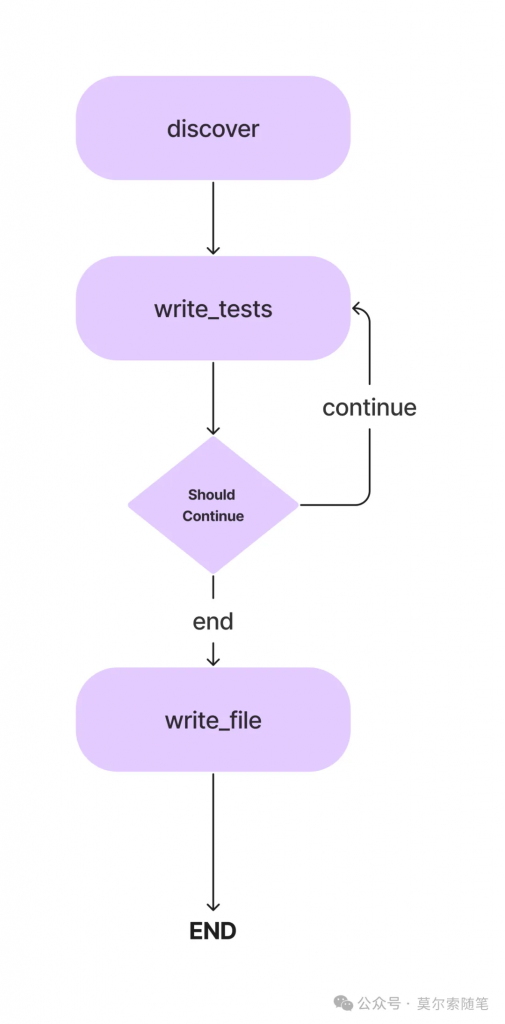 “`
“`
定义入口点,这是流程开始的地方
workflow.set_entry_point("discover")
总是从discover跳转到write_tests
workflow.add_edge("discover", "write_tests")
add_conditional_edge 函数添加了 write_tests 函数和 should_continue 函数,该函数根据 class_methods 条目决定采取哪一步,判断是否完成
def should_continue(state: AgentState):
if len(state["class_methods"]) == 0:
如果没有更多的方法要测试
return "end"结束流程
else:
return "continue"继续流程
添加条件边
workflow.add_conditional_edges(
"write_tests",
条件边的起始节点
should_continue,条件函数
{
"continue": "write_tests",如果应该继续,则再次执行write_tests节点
"end": "write_file"如果结束,则跳转到write_file节点
})
总是从write_file跳转到END
workflow.add_edge("write_file", END)
当从 LLM 生成所有方法的单元测试后,测试代码被写入测试文件。
### __4. 执行工作流__
最后剩下的就是编译工作流并运行它。app = workflow.compile()
编译工作流
inputs = {}
输入参数
config = RunnableConfig(recursion_limit=100)
设置递归限制
try:
result = app.invoke(inputs, config)
运行应用
print(result)打印结果
except GraphRecursionError:
如果达到递归限制
print("达到图递归限制。")打印错误信息
递归限制是给定工作流的 LLM 进行循环推理的次数,当超过限制时,工作流停止。
### __5. 生成的单元测试文件__
下面是最终生成的 test_crud.py 文件的内容,大家自行评判。class TestDict(unittest.TestCase):
def test_crudapp_init():
创建一个CRUDApp实例
app = CRUDApp()验证items列表是否为空
assert app.items == []
def test_item_repr():
item = Item(1, 'Test Item', 'This is a test item')
expected_repr = "Item(id=1, name=Test Item, description=This is a test item)"
assert repr(item) == expected_repr
def test_crudapp_init():创建一个CRUDApp实例
app = CRUDApp()验证items列表是否为空
assert app.items == []
def test_create_item():初始化CRUDApp实例
app = CRUDApp()创建一个新项目
item = app.create_item(1, 'Test Item')断言项目已创建并存在于项目列表中
assert item in app.list_items()
assert item.id == 1
assert item.name == 'Test Item'
assert item.description is None创建另一个项目,确保ID是唯一的
another_item = app.create_item(2, 'Another Test Item')
assert another_item in app.list_items()
assert another_item.id == 2
assert another_item.name == 'Another Test Item'
assert another_item.description is None断言列表中的项目数量正确
assert len(app.list_items()) == 2
def test_read_item():初始化CRUDApp实例
app = CRUDApp()创建一个测试项
test_item = app.create_item(1, 'Test Item')测试读取存在的项
read_item = app.read_item(1)
assert read_item == test_item测试读取不存在的项
non_existent_item = app.read_item(99)
assert non_existent_item is None
def test_update_item():初始化CRUDApp实例
app = CRUDApp()创建一个测试用的Item
item = app.create_item(1, 'Test Item')更新Item的名称
updated_item = app.update_item(1, 'Updated Test Item')验证更新是否成功
assert updated_item is not None
assert updated_item.id == 1
assert updated_item.name == 'Updated Test Item'
assert updated_item.description is None验证列表中的Item是否更新
listed_items = app.list_items()
assert len(listed_items) == 1
assert listed_items[0].id == 1
assert listed_items[0].name == 'Updated Test Item'
assert listed_items[0].description is None尝试更新不存在的Item
non_existent_item = app.update_item(2, 'Non Existent Item')
assert non_existent_item is None更新Item的描述
updated_item_description = app.update_item(1, description='Updated Test Description')验证更新是否成功
assert updated_item_description is not None
assert updated_item_description.id == 1
assert updated_item_description.name == 'Updated Test Item'
assert updated_item_description.description == 'Updated Test Description'验证列表中的Item是否更新
listed_items = app.list_items()
assert len(listed_items) == 1
assert listed_items[0].id == 1
assert listed_items[0].name == 'Updated Test Item'
assert listed_items[0].description == 'Updated Test Description'
def test_delete_item():创建一个CRUDApp实例
app = CRUDApp()创建一些测试用的Item对象
item1 = app.create_item(1, 'Item 1')
item2 = app.create_item(2, 'Item 2')验证创建的Item对象是否在列表中
assert item1 in app.list_items()
assert item2 in app.list_items()删除一个Item对象
deleted_item = app.delete_item(1)验证删除操作是否成功
assert deleted_item == item1
assert item1 not in app.list_items()
assert item2 in app.list_items()尝试删除一个不存在的Item对象
deleted_nonexistent_item = app.delete_item(3)验证删除不存在的Item对象时返回None
assert deleted_nonexistent_item is None
def test_list_items():创建一个CRUDApp实例
app = CRUDApp()创建一些测试用的Item实例
item1 = app.create_item(1, 'Item 1')
item2 = app.create_item(2, 'Item 2', 'This is item 2')调用list_items方法并检查返回的列表是否包含我们创建的Item实例
listed_items = app.list_items()
assert item1 in listed_items
assert item2 in listed_items检查列表的长度是否正确
assert len(listed_items) == 2## 结论
生成的单元测试,属于是一种基本可用的状态,多次(10 次)执行输出的结果也较为稳定,通过和 GPT-4-Turbo、GLM-4 生成的进行比较,DeepSeek-V2 在一些 Agent 应用场景确实可以做到平替,毕竟百分之一的成本,性价比在这里摆着,还要啥自行车,等我后续在其他更复杂的 Agent 项目进行进一步验证。
## 参考资料
[1]疯狂的幻方:一家隐形 AI 巨头的大模型之路: *https://36kr.com/p/2272896094586500*
[2]MoE 架构: *https://baoyu.io/translations/llm/what-is-mixture-of-experts*
[3]Build an AI Coding Agent with LangGraph by LangChain: *https://www.analyticsvidhya.com/blog/2024/03/build-an-ai-coding-agent-with-langgraph-by-langchain/*
文章转自[微信公众号@莫尔索随笔](https://mp.weixin.qq.com/s/cVbwsPutLjAMj9z7nY0g3A)最新文章
- 小红书AI文章风格转换:违禁词替换与内容优化技巧指南
- REST API 设计:过滤、排序和分页
- 认证与授权API对比:OAuth vs JWT
- 如何获取 Coze开放平台 API 密钥(分步指南)
- 首次构建 API 时的 10 个错误状态代码以及如何修复它们
- 当中医遇上AI:贝业斯如何革新中医诊断
- 如何使用OAuth作用域为您的API添加细粒度权限
- LLM API:2025年的应用场景、工具与最佳实践 – Orq.ai
- API密钥——什么是API Key 密钥?
- 华为 UCM 推理技术加持:2025 工业设备秒级监控高并发 API 零门槛实战
- 使用JSON注入攻击API
- 思维链提示工程实战:如何通过API构建复杂推理的AI提示词系统